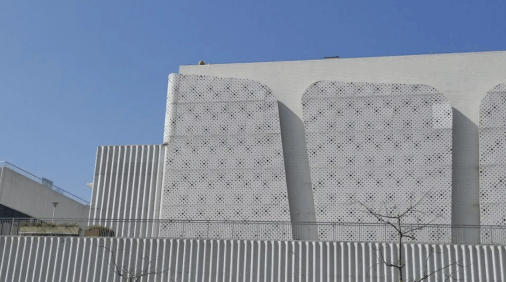Facade panels have emerged as an essential design element in modern architecture, transforming the exterior aesthetics of buildings while offering numerous functional advantages. This blog post will delve into the world of facade panels, exploring their benefits, materials, and innovative applications in contemporary construction.
As technology continues to advance, we can expect to see even more innovative and sustainable facade panel solutions that will reshape the architectural landscape.
The Purpose of Facade Panels
Facade panels play a vital role in enhancing the visual appeal of a building while providing functional benefits like thermal insulation, weather resistance, and sound attenuation. They serve as the outermost layer of a building, shielding its structural elements from external elements while contributing to its overall aesthetics. Facade panels can be easily customized, offering architects the creative freedom to design visually striking exteriors that embody the character of a space.
Materials Used in Facade Panels
A wide range of materials can be used to create facade panels, each with its unique characteristics and advantages. Some popular materials include:
A.Aluminum curtain wall: lightweight, high strength, resist shock, waterproof, fireproof, anti-dirt and anti-corrosion. Simple structure, the installation is very easy. Flexible processing, the size and design of the panels is customized, then you can start installation directly when you receive the panels.
B. Aluminum Composite Panels (ACP): ACP are lightweight, durable, and low maintenance, making them an ideal choice for commercial and residential projects. They offer excellent thermal insulation and soundproofing properties.
C. Fiber Cement Panels: These panels are made from a mix of cement, cellulose fibers, and water. They are known for their durability, moisture resistance, and fire safety features.
D. High-Pressure Laminate (HPL): HPL panels are made from layers of paper and resin, bonded under high pressure and temperature. They offer an extensive range of colors and patterns, making them a popular choice for designers.
E. Terracotta Panels: Terracotta panels are made from natural clay, offering a unique and organic aesthetic. They are eco-friendly, breathable, and can help regulate indoor temperatures.
F. Glass Panels: Glass panels provide an elegant and modern appearance, allowing natural light to flood a building’s interior. They can also offer energy efficiency through advanced glazing technology.
Facade Panels Are Becoming The Newest Trend In Building Materials
1. Design Flexibility and Customization
Facade panels offer architects and designers unparalleled freedom to create unique and visually stunning exteriors. They can be customized in terms of colors, textures, patterns, and shapes, allowing for the creation of bespoke facades that reflect the building’s character and purpose. Furthermore, facade panels can be combined with other materials, such as glass and metal, to create innovative and striking designs.
2. Energy Efficiency and Sustainability
Modern facade panels can significantly contribute to a building’s energy efficiency by providing improved insulation and reducing heat gain or loss. Some materials, like terracotta and fiber cement, are also environmentally friendly and sustainable, making them an ideal choice for green building projects.
3. Maintenance and Durability
Facade panels are designed to be low-maintenance and highly durable, resisting the effects of weather, UV exposure, and pollution. They can retain their appearance and structural integrity for many years, reducing the need for frequent repairs or replacements.
Facade Panels: Creating a Facade With Extensive Outdoor Structure and Panels
The facade of your building is the first thing that visitors see when they approach your business. It’s the first impression you give to all potential customers, so it’s important that it stands out and makes a good impression.
The right facade can make all the difference between people seeing your business as an established, professional brand or as a cheap knockoff of something they could get at a discount store. That’s why we offer a wide variety of facade panels for businesses looking to upgrade their storefronts with a professional appearance.
What’s the Difference Between a Shop Front and Facade Panel?
Shop fronts and facade panels are both components of a building’s exterior design, but they serve different purposes and have distinct characteristics.

Shop Front:
A shop front is the exterior face of a retail or commercial establishment, usually at street level. It typically includes elements such as windows, doors, signage, awnings, and lighting. The main purpose of a shop front is to create an inviting and attractive entrance for customers, showcasing the products or services offered inside and promoting the brand’s identity. Shop fronts are crucial for attracting foot traffic, and their design can have a significant impact on the success of a business.
Key features of shop fronts include:
1) A focus on creating an attractive and welcoming entrance
2) The incorporation of branding elements such as logos, signage, and colors
3) The use of display windows to showcase products and promotions
4) The inclusion of functional elements such as doors, handles, and lighting
Facade Panel:
Facade panels, on the other hand, are exterior cladding components used to cover the outer surface of a building. Their primary purpose is to provide a protective layer against external elements while enhancing the building’s aesthetic appeal. Facade panels can be used on various types of buildings, including residential, commercial, and industrial structures.
Key features of facade panels include:
1) Providing a protective layer against weather, moisture, and other environmental factors.
2) Enhancing the building’s aesthetic appeal through various materials, colors, and textures.
3) Offering thermal insulation and sound attenuation properties.
4) The poallowsfor customization, allowing architects and designers to create unique and visually striking exteriors.
In summary, the main difference between a shop front and a facade panel lies in their functions and applications. A shop front is specifically designed for retail and commercial establishments to attract customers and showcase products or services, while facade panels are used to protect and enhance the appearance of a building’s exterior. Both components contribute to the overall aesthetic of a building, but they serve different purposes within the architectural design.
High-Quality ManyBest Customized Facade Panels for Sale
The ManyBest facade panels are available in a wide range of materials, including aluminum composite panels (ACP). Each material offers distinct advantages, allowing customers to select the best option for their specific project requirements. ManyBest’s commitment to quality ensures that all panels are manufactured using top-grade materials and adhere to stringent industry standards.
One of the standout features of ManyBest’s facade panels is their design flexibility. Clients can choose from an extensive array of colors, textures, patterns, and shapes, allowing them to create unique and visually striking exteriors that reflect the building’s character and purpose. ManyBest also offers the option to combine different materials, enabling architects and designers to craft innovative designs that push the boundaries of modern architecture.
Bottom Line
ManyBest, a renowned manufacturer of building materials, has announced the launch of its new line of high-quality, customizable facade panels. These panels are designed to cater to the diverse needs of architects, designers, and builders, providing them with a versatile and aesthetically pleasing solution for both residential and commercial projects.



